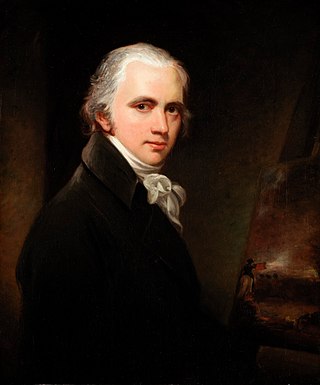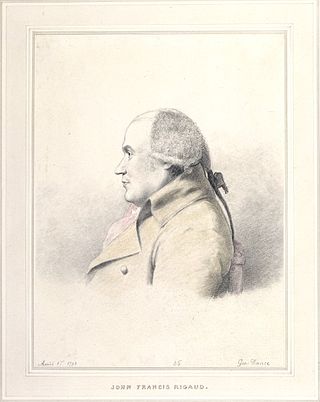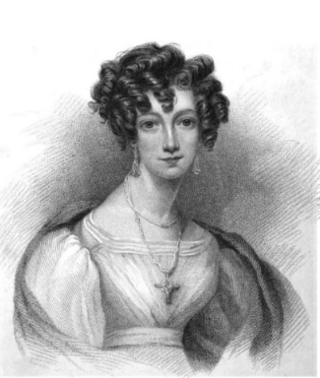
Michael William Sharp (1776? – 1840) was an English painter.

Michael William Sharp (1776? – 1840) was an English painter.
He was born in London, and was a pupil of Sir William Beechey. He also studied in the schools of the Royal Academy. In about 1804 he married the actress and dancer Arabella Menage (1782–1817). In 1813 he was in Norwich, where he lodged with John Crome, perhaps a former teacher, and godfather to one of his sons. He became one of the prominent painters of the Norwich school, with whom he exhibited for some years. Sharp later was in London, and died at Boulogne in 1840. [1]

Sharp appeared as a portrait-painter at the Royal Academy in 1801, but he became known as a painter of small domestic scenes, usually of a humorous character. His works were populist, and successful in his day. [1]
The Music Master, exhibited at the British Institution in 1809, gained a premium and was purchased by Thomas Hope. Sharp obtained many commissions, and his pictures sold well at the exhibitions. Many of them also were engraved, such as Sunday Morning (R.A. 1820), The Sailor's Wedding (R.A. 1828), The Black Draught, and The Spoilt Child. [1]

The Connoisseur, a capriccio painting of Thomas Hope's London Duchess Street Residence and world famous art collections, featured group portraits of Thomas Hope, his wife Louisa, John Keyes, Madam Vestris, and other notables of the day along with costumed members of the Drury Lane Theater Company. Painted in 1811, the large 48 1/2" X 40" canvas was shown in the Annual Exhibition of British Artists in the Gallery of the British Institution in Pall Mall during the summer of 1812. The painting was purchased at the Exhibition, by George Spencer-Churchill, the Marquis of Blandford who would later become the 5th Duke of Marlborough, and this painting would hang on display at the Duke's famous White Knights estate until 1819 when he went bankrupt and all of his possessions were sold at auction. [2]
Sharp also executed for theatrical patrons group portraits of the principal performers on the stage at that time, such as Queen Constance before the Tents of the English and Foreign Sovereigns, painted in 1819; An Author reading his Drama to an Assemblage of the Performers in the Green Room of Drury Lane Theatre; The Shakespeare Jubilee, with Portraits of the principal Covent Garden Performers, and others. [1]
A lecture by Sharp, delivered in 1820 to the Philosophical Society at Norwich, was printed. It is in James Elmes's Annals of the Fine Arts, vols. iv. and v., as An Essay on Gesture. [1]
![]() This article incorporates text from a publication now in the public domain : Lee, Sidney, ed. (1897). "Sharp, Michael William". Dictionary of National Biography . Vol. 51. London: Smith, Elder & Co.
This article incorporates text from a publication now in the public domain : Lee, Sidney, ed. (1897). "Sharp, Michael William". Dictionary of National Biography . Vol. 51. London: Smith, Elder & Co.

Thomas Phillips was a leading English portrait and subject painter. He painted many of the great men of the day including scientists, artists, writers, poets and explorers.

Joseph Stannard was an English marine, landscape and portrait painter. He was a talented and prominent member of the Norwich School of painters.

Mason Chamberlin (1727–1787) was an English portrait painter, who was one of the founding members of the Royal Academy in 1768. He was a student of Francis Hayman. He is perhaps best remembered for his portrait of Benjamin Franklin.

Sir George Scharf KCB was a British art critic, illustrator, and director of the National Portrait Gallery.

Sir William Beechey was a British portraitist during the golden age of British painting.

James Stark was an English landscape painter. A leading member of the Norwich School of painters, he was elected vice-president of the Norwich Society of Artists in 1828 and became their president in 1829. He had wealthy patrons and was consistently praised by the Norfolk press for his successful London career.

George Vincent was an English landscape painter who produced watercolours, etchings and oil paintings. He is considered by art historians to be one of the most talented of the Norwich School of painters, a group of artists connected by location and personal and professional relationships, who were mainly inspired by the Norfolk countryside. Vincent's work was founded on the Dutch school of landscape painting as well as the style of John Crome, also of the Norwich School. The school's reputation outside East Anglia in the 1820s was based largely upon the works of Vincent and his friend James Stark.

Julia Goodman was a British portrait painter.
Henry Brittan Willis was an English landscape and animal painter.

John Francis Rigaud was an eighteenth-century history, portrait, and decorative painter. Of French descent, he was born in Turin and spent most of his career in England.

Archer James Oliver was a British painter, principally active as a portraitist.

James Digman Wingfield (1800–1872) was a British painter, known mainly for historical subjects, as well as for landscapes, portraits, and interiors.

John Cawse was a British painter and caricaturist.
William Derby (1786–1847) was an English portraitist, miniature painter and copyist.
Mary Martha Pearson was an English portrait painter.

The Williams family of painters, also known as the Barnes School, is a family of prominent 19th-century Victorian landscape artists known for their paintings of the British countryside, coasts and mountains. They are represented by the artist Edward Williams (1781–1855), his six sons, and several grandchildren.

Thomas Foster was an Irish portrait painter.
Edith Hipkins (1854–1945) was a British portrait and genre painter. She exhibited five paintings at the Royal Academy of Arts (RA) between 1883 and 1898.
William Hemsley was a British artist who specialised in genre paintings.

Maria Ann Chalon was a British painter of miniatures. She was Portrait Paintress to his Royal Highness, the Duke of York, and is considered one of the most talented and successful female British miniaturists of the early nineteenth century.